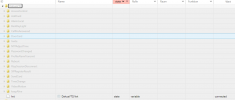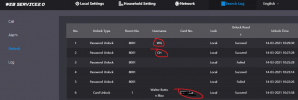const DigestFetch = require('digest-fetch');
const net = require('net');
const fs = require('fs');
const path = require('path');
const md5 = require('md5');
const mqtt = require('mqtt');
/**
* Class to abstract a dahua doorbell.
*
* On instantiation it automatically connects with the doorbell, logs in and
* subscribes to all events.
*
* When an event is received, it forwards it to the MQTT broker so other systems
* can received those events. This behavior is very generic, users need to listen
* to those MQTT messages and create their own integrations using something like
* node-red for instance.
*
* In time this could be used to create a more user-friendly integration in home assistant,
* but a doorbell is a complicated device and I don't know enough yet to decide how such
* integration would look.
*/
class DahuaVTO {
deviceType;
serialNumber;
/**
* {Number} requestId
*
* Our Request / Response ID that must be in all requests and initated by us.
* This number auto-increments every time we send a message. Once we've logged in, every
* response contains the request id of which it's a response of, se it could be used to
* match responses with requests.
*
* I haven't bothered to do so because ,for what I saw, we only care about response order
* for the initial setup, and we do that on request at a time.
*
* If we ever make requests in parallel and we need to associate response to each request,
* we could use this. For not, it's just an auto-incremental number.
* */
requestId = 0;
// Session ID will be returned after successful login
/**
* {Number} sessionId
*
* When we try to log in on the doorbell we get a sessionId. From that point on every message
* we send over the socket needs to have include the sessionID for the doorbell to recognize us.
*/
sessionId = 0;
// Will be set after the login, but we initialize to 60s because it's a reasonable default
/**
* {Number} keepAliveInterval
*
* The number of seconds we have to space our keepAlive messages so the doorbell doesn't close
* the connection.
*/
keepAliveInterval = 60;
/**
* The ID returned by the `setInterval` call.
* We keep a reference in case we want to cancel it (maybe in case of failure?)
*/
_keepAliveTimer;
/**
* TCP socket to communicate with the doorbell external unit.
*/
doorbellSocket;
/**
* MQTT client to publish (and maybe receive) messages.
*/
mqttClient;
constructor() {
this.dahua_host = "10.0.0.xx";
this.dahua_username = "user";
this.dahua_password = "pass";
this.mqtt_broker_host = "10.0.0.xx";
this.mqtt_broker_port = "1883";
this.mqtt_broker_username = "";
this.mqtt_broker_password = "";
this.mqtt_broker_topic_prefix = "DahuaVTO";
this.digestClient = new DigestFetch(
this.dahua_username,
this.dahua_password
);
this.getDeviceDetails().then(({ deviceType, serialNumber }) => {
this.deviceType = deviceType;
this.serialNumber = serialNumber;
this.start();
});
}
/**
* Starts the app by:
* - Opening a TCP socket to the doorbell
* - Connecting to the MQTT broker
* - Authenticating with the doorbell and subscribing to events.
*/
start() {
this.setupDoorbellSocket();
this.setupMQTT();
this.initLogin();
}
/**
* Makes a request to the doorbell using digest auth to retrieve the device's information.
*
* The information is returned in plain text (not JSON) that we have to parse.
* For now I think we only care about device type and serial number, which can be
* used to disambiguate in case we have more than one doorbell.
*/
async getDeviceDetails() {
return this.digestClient
.fetch(
`http://${this.dahua_host}/cgi-bin/magicBox.cgi?action=getSystemInfo`
)
.then((r) => r.text())
.then((text) => {
const deviceDetails = text
.trim()
.split('\n')
.reduce((obj, str) => {
const [key, val] = str.split('=');
obj[key] = val.trim();
return obj;
}, {});
return deviceDetails;
});
}
/**
* Saves a snapshot of the doorbells image into the given directory (defaults to /tmp/).
*
* By default the file is named with a simple timestamp of the current time (YYYY-MM-DD-H-M-S.jpg)
*
*/
saveSnapshot(p = '/tmp/') {
let now = new Date();
let dateStr = `${now.getFullYear()}-${
now.getMonth() + 1
}-${now.getDate()}-${now.getHours()}-${now.getMinutes()}-${now.getSeconds()}`;
let destination = path.join(p, `DoorBell_${dateStr}.jpg`);
this.digestClient
.fetch(`http://${this.dahua_host}/cgi-bin/snapshot.cgi`)
.then((r) => {
return r.buffer();
})
.then((buf) => {
fs.writeFile(destination, buf, 'binary', function (err) {
if (err) {
log('Error saving snapshot to disk', err);
} else {
log('Snapshot saved');
}
});
});
}
/**
* Creates the TCP socket connection with the doorbell on port 5000.
*
* Setups the listener for when we receive data over that socket
*
* Also setups other listeners for logging purposes mostly.
*
* If something goes wrong, we close everything and try to start over again.
*/
setupDoorbellSocket() {
let socket = new net.Socket({ readable: true, writable: true });
socket.on('end', function () {
log('Doorbell socket ended');
});
socket.on('close', function () {
log('Doorbell socket closed');
clearInterval(this._keepAliveTimer);
});
socket.on('data', this.receive.bind(this));
socket.on('error', function (e) {
log('Doorbell socket error', e);
this.doorbellSocket.destroy(); // destroy the socket
this.mqttClient.end(true); // End the mqtt connection right away.
clearInterval(this._keepAliveTimer); // Stop sending keepalive requests
this.start(); // Start over again.
});
this.doorbellSocket = socket.connect({ port: 5000, host: this.dahua_host });
}
/**
* Configure an initialize the MQTT client.
*
* It configures the "Last Will and Testament" (LWT), which is the message send to MQTT
* if this client gets disconnected in an ungraceful way (e.g. a fatal error).
*
* It also adds listeners that right now are only used for logging.
*/
setupMQTT() {
this.mqttClient = mqtt.connect({
host: this.mqtt_broker_host,
port: this.mqtt_broker_port,
username: this.mqtt_broker_username,
password: this.mqtt_broker_password,
will: {
topic: `${this.mqtt_broker_topic_prefix}/lwt`,
payload: 'connected',
qos: 1,
},
});
this.mqttClient.on('disconnect', function (packet) {
log('MQTTDisconnect', packet);
});
this.mqttClient.on('message', function (topic, message, packet) {
log('MQTTMessage', { topic, message, packet });
});
}
/**
* Publishes to MQTT an event with the given name and payload.
* @param {string} name
* @param {object} payload
*/
publishToMQTT(name, payload) {
let message = JSON.stringify(payload);
this.mqttClient.publish(
`${this.mqtt_broker_topic_prefix}/${name}/Event`,
message
);
}
/**
* Sends a message with the given data to the doorbell's outside unit using the TCP socket.
* @param {string} data
*
* This is a fairly low level way of communication, so let's dive in.
*
* We write binary to the socket, so we have to use buffers.
*
* The first 32 bytes of the message are the header.
* After the header we concat the actual message, which is a JSON string.
* The header has some bits that are fixed and others that are the length of the message that will
* come after.
*
* I didn't reverse-engineered this myself but it works. Take it as gospel as I did.
*/
send(data) {
let json = JSON.stringify(data);
let buf = Buffer.alloc(32);
let offset = buf.writeUInt32BE(0x20000000);
offset = buf.writeUInt32BE(0x44484950, offset);
offset = buf.writeDoubleBE(0, offset);
offset = buf.writeUInt32LE(json.length, offset);
offset = buf.writeUInt32LE(0, offset);
offset = buf.writeUInt32LE(json.length, offset);
offset = buf.writeUInt32LE(0, offset);
buf = Buffer.concat([buf, Buffer.from(json)]);
this.requestId += 1;
this.doorbellSocket.write(buf);
}
/**
* Handles received messages from the TCP socket.
* @param {Buffer} buf
*
* The received messages are binary. Once discarded the first 32 bytes (the header),
* the rest of the message is parsed as as a JSON string.
*
* The header contains the length of the received response in bytes 16..20 and the expected
* length of the response in bytes 24..28 in case we need it, but I haven't found a
* reason to. Perhaps responses might be sent in several chunks? So far it doesn't seem to be
* the case.
*
* Since we always make requests in the exact same order, we know the first two responses are
* for the authentication.
* Subsequent responses can be either events or keepalive responses.
*/
receive(buf) {
let str = buf.slice(32).toString();
let obj = JSON.parse(str);
if (this.requestId === 1) {
this.handleFirstLoginPayload(obj);
} else if (this.requestId === 2) {
this.handleSecondLoginPayload(obj);
} else if (obj.method === 'client.notifyEventStream') {
this.handleEvents(obj.params.eventList);
} else {
this.handleGenericPayload(obj);
}
}
/**
* Sends the initial login request.
* Note that does not include any password.
* The response to this request will be negative but that is expected, it will contain the
* necessary information to login.
*/
initLogin() {
this.send({
id: 10000,
magic: '0x1234',
method: 'global.login',
params: {
clientType: '',
ipAddr: '(null)',
loginType: 'Direct',
password: '',
userName: this.dahua_username,
},
session: 0,
});
}
/**
* Handles the response to the initial login request.
*
* The response contains a session ID, a realm and a random, which in combination with
* the username and the password are used to generate an MD5 password that is used
* for logging in.
*
* @param {object} payload
*/
handleFirstLoginPayload({ session, params: { random, realm } }) {
this.sessionId = session;
let randomHash = this.genMD5Hash(random, realm);
this.send({
id: 10000, // I assume this ID a high number just because we have to send something.
magic: '0x1234', // No idea what this is
method: 'global.login',
session: this.sessionId,
params: {
userName: this.dahua_username,
password: randomHash,
clientType: '',
ipAddr: '(null)',
loginType: 'Direct',
authorityType: 'Default',
},
});
}
/**
* Handles the response to the second (and last) response to login request.
*
* If successful, any subsequent message that includes the session id will be accepted for
* as long as the socket is not closed.
*
* To prevent the socket from closing we send a keepalive message every so often.
*
* Also now that we're authenticated we subscribe to all events fired by the doorbell.
*/
handleSecondLoginPayload(obj) {
if (obj.result) {
log('Logging to Dahua Doorbell successful');
this.keepAliveInterval = obj.params.keepAliveInterval - 5;
this.attachEventManager();
this.keepConnectionAlive();
} else {
log('Failed to login. Response was: ', obj);
}
}
/**
* Handles any response not handled by any other method. I believe only keepalive responses
* will end up here, but added some logging just in case.
*
* For now keepalive events are published to MQTT, but I don't see a good reason for that.
*/
handleGenericPayload(obj) {
if (
obj.result === true &&
obj.params &&
Object.hasOwnProperty.call(obj.params, 'timeout')
) {
log('Publish KeepAlive event');
this.publishToMQTT('keepAlive', {
deviceType: this.deviceType,
serialNumber: this.serialNumber,
});
} else {
log(
'handleGenericPayload# Cannot handle received payload',
obj
);
}
}
/**
* Generates a MD5 digest of the username, password, realms and random to send as
* password when logging in.
* @param {*} random
* @param {*} realm
*/
genMD5Hash(random, realm) {
const base_credentials = `${this.dahua_username}:${realm}:${this.dahua_password}`;
const pwddb_hash = md5(base_credentials).toUpperCase();
const base_pass = `${this.dahua_username}:${random}:${pwddb_hash}`;
return md5(base_pass).toUpperCase();
}
/**
* Sends the message to subscribe to all dorbell events.
*/
attachEventManager() {
this.send({
id: this.requestId,
magic: '0x1234',
method: 'eventManager.attach',
params: {
codes: ['All'],
},
session: this.sessionId,
});
}
/**
* Handles the events sent by the doorbell.
*
* It just publishes those events along with some information of the device firing them
* to MQTT
*/
handleEvents(events) {
events.forEach((event) => {
log(`Publish event ${event.Code} to MQTT`);
this.publishToMQTT(event.Code, {
Action: event.eventAction,
Data: event.Data,
deviceType: this.deviceType,
serialNumber: this.serialNumber,
});
});
}
/**
* Sets up a function to be called periodically to keep the socket open by sending
* keepalive messages.
* @param {Number} delay (in seconds)
*/
keepConnectionAlive(delay) {
this._keepAliveTimer = setInterval(() => {
let keepAlivePayload = {
method: 'global.keepAlive',
magic: '0x1234',
params: {
timeout: delay,
active: true,
},
id: this.requestId,
session: this.sessionId,
};
this.send(keepAlivePayload);
}, this.keepAliveInterval * 1000);
}
/**
* Remotely triggers the relay 1 (e.g. to open an electric gate).
*
* In my VTO 2202 F this also triggers the voice announcing the the door has been opened.
*/
openDoor() {
return this.digestClient
.fetch(
`http://${this.dahua_host}/cgi-bin/accessControl.cgi?action=openDoor&channel=1&UserID=101&Type=Remote`
)
.then((r) => {
if (r.ok) {
log('Door relay triggered');
} else {
log('Error triggering the door relay', e);
}
})
.catch(e => log('Connection error triggering the door relay'));
}
// requestMissedCallsLog() {
// this.send({
// id: this.requestId,
// magic: '0x1234',
// method: 'RecordFinder.factory.create',
// params: {
// name: 'VideoTalkMissedLog',
// },
// session: this.sessionId,
// });
// }
// requestMissedCallsLog2(findToken) {
// this.send({
// id: this.requestId,
// magic: '0x1234',
// method: 'RecordFinder.startFind',
// object: findToken,
// params: { condition: null },
// session: this.sessionId,
// });
// }
// requestMissedCallsLog3(findToken) {
// this.send({
// id: this.requestId,
// magic: '0x1234',
// method: 'RecordFinder.doFind',
// object: findToken,
// params: { count: 3 }, // Number of calls to show
// session: this.sessionId,
// });
// }
};
exports.default = DahuaVTO;
new DahuaVTO();








